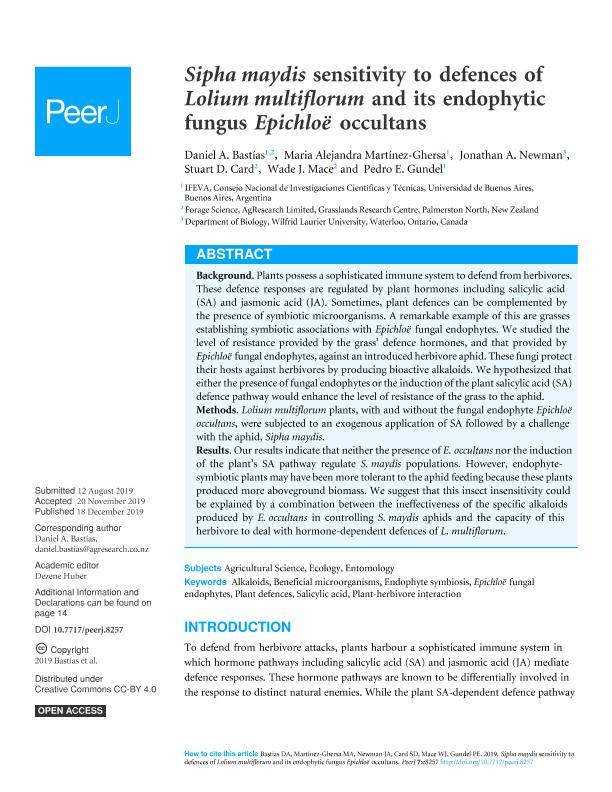Artículo
Sipha maydis sensitivity to defences of Lolium multiflorum and its endophytic fungus Epichloë occultans
Bastias, Daniel; Martinez-Ghersa, Maria Alejandra ; Newman, Jonathan A.; Card, Stuart D.; Mace, Wade J.; Gundel, Pedro Emilio
; Newman, Jonathan A.; Card, Stuart D.; Mace, Wade J.; Gundel, Pedro Emilio
 ; Newman, Jonathan A.; Card, Stuart D.; Mace, Wade J.; Gundel, Pedro Emilio
; Newman, Jonathan A.; Card, Stuart D.; Mace, Wade J.; Gundel, Pedro Emilio
Fecha de publicación:
12/2019
Editorial:
PeerJ Inc.
Revista:
PeerJ
ISSN:
2167-8359
Idioma:
Inglés
Tipo de recurso:
Artículo publicado
Clasificación temática:
Resumen
Background. Plants possess a sophisticated immune system to defend from herbivores. These defence responses are regulated by plant hormones including salicylic acid (SA) and jasmonic acid (JA). Sometimes, plant defences can be complemented by the presence of symbiotic microorganisms. A remarkable example of this are grasses establishing symbiotic associations with Epichloë fungal endophytes. We studied the level of resistance provided by the grass’ defence hormones, and that provided by Epichloë fungal endophytes, against an introduced herbivore aphid. These fungi protect their hosts against herbivores by producing bioactive alkaloids. We hypothesized that either the presence of fungal endophytes or the induction of the plant salicylic acid (SA) defence pathway would enhance the level of resistance of the grass to the aphid. Methods. Lolium multiflorum plants, with and without the fungal endophyte Epichloë occultans, were subjected to an exogenous application of SA followed by a challenge with the aphid, Sipha maydis. Results. Our results indicate that neither the presence of E. occultans nor the induction of the plant’s SA pathway regulate S. maydis populations. However, endophytesymbiotic plants may have been more tolerant to the aphid feeding because these plants produced more aboveground biomass. We suggest that this insect insensitivity could be explained by a combination between the ineffectiveness of the specific alkaloids produced by E. occultans in controlling S. maydis aphids and the capacity of this herbivore to deal with hormone-dependent defences of L. multiflorum.
Archivos asociados
Licencia
Identificadores
Colecciones
Articulos(IFEVA)
Articulos de INST.D/INV.FISIOLOGICAS Y ECO.VINCULADAS A L/AGRIC
Articulos de INST.D/INV.FISIOLOGICAS Y ECO.VINCULADAS A L/AGRIC
Citación
Bastias, Daniel; Martinez-Ghersa, Maria Alejandra; Newman, Jonathan A.; Card, Stuart D.; Mace, Wade J.; et al.; Sipha maydis sensitivity to defences of Lolium multiflorum and its endophytic fungus Epichloë occultans; PeerJ Inc.; PeerJ; 7; e8257; 12-2019; 1-21
Compartir
Altmétricas



